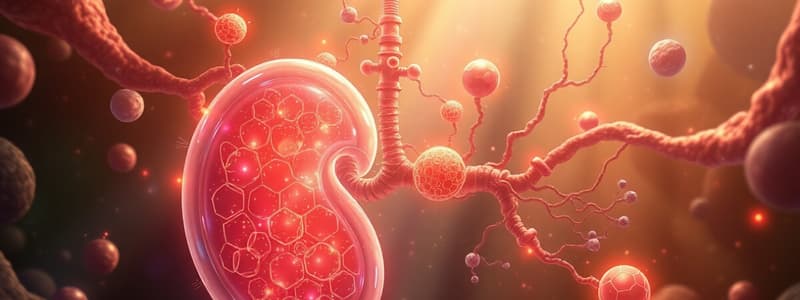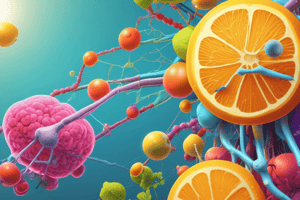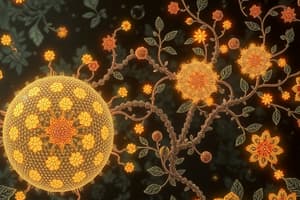Podcast
Questions and Answers
During glycolysis, what is the primary molecule that is produced?
During glycolysis, what is the primary molecule that is produced?
- Oxygen
- Acetyl-CoA
- Fatty acids
- ATP (correct)
NADH is produced during glycolysis and through the Krebs Cycle.
NADH is produced during glycolysis and through the Krebs Cycle.
True (A)
What molecule combines with pyruvate in the mitochondrial matrix during pyruvate oxidation?
What molecule combines with pyruvate in the mitochondrial matrix during pyruvate oxidation?
CoA
The end product of the Krebs Cycle is _____, which is then used to regenerate the cycle.
The end product of the Krebs Cycle is _____, which is then used to regenerate the cycle.
Match the energy carrier with its function:
Match the energy carrier with its function:
Which process directly produces ATP in the Krebs Cycle?
Which process directly produces ATP in the Krebs Cycle?
The Krebs Cycle occurs in the cytoplasm of eukaryotic cells.
The Krebs Cycle occurs in the cytoplasm of eukaryotic cells.
Name the two 3-carbon molecules produced from glucose during glycolysis.
Name the two 3-carbon molecules produced from glucose during glycolysis.
Which of the following terms refers to the breakdown of glucose during cellular respiration?
Which of the following terms refers to the breakdown of glucose during cellular respiration?
The Krebs Cycle produces ATP directly.
The Krebs Cycle produces ATP directly.
What is the primary purpose of the Electron Transport Chain in cellular respiration?
What is the primary purpose of the Electron Transport Chain in cellular respiration?
In the redox reaction of NAD, it gets reduced to form ______.
In the redox reaction of NAD, it gets reduced to form ______.
Match the following energy carriers with their reduced forms:
Match the following energy carriers with their reduced forms:
Which of the following describes exergonic reactions?
Which of the following describes exergonic reactions?
Oxidative phosphorylation occurs in the mitochondria.
Oxidative phosphorylation occurs in the mitochondria.
What is the main product formed during glycolysis?
What is the main product formed during glycolysis?
In cellular respiration, the energy produced from glucose is harnessed into ______.
In cellular respiration, the energy produced from glucose is harnessed into ______.
How many ATP molecules are produced from the glycolysis process?
How many ATP molecules are produced from the glycolysis process?
FADH2 generates more ATP than NADH during the electron transport chain.
FADH2 generates more ATP than NADH during the electron transport chain.
What is the primary function of the electron transport chain?
What is the primary function of the electron transport chain?
The final acceptor of electrons in the electron transport chain is __________.
The final acceptor of electrons in the electron transport chain is __________.
Match the following terms with their corresponding descriptions:
Match the following terms with their corresponding descriptions:
What is the total possible ATP yield from one glucose molecule during aerobic respiration?
What is the total possible ATP yield from one glucose molecule during aerobic respiration?
Electrochemical gradients are not important for ATP production.
Electrochemical gradients are not important for ATP production.
Which enzyme catalyzes step 3 of glycolysis?
Which enzyme catalyzes step 3 of glycolysis?
Flashcards are hidden until you start studying
Study Notes
Reduced Molecules
- When a molecule accepts electrons, its overall positive charge decreases.
Oxidative Phosphorylation
- ATP is formed indirectly.
- Uses redox reactions.
- Involves NADH and FADH2.
- The molecules harvest energy, which is transferred to ATP by the end of cellular respiration.
Glycolysis
- A glucose molecule is broken down into two pyruvate molecules.
- Occurs in the cytoplasm.
- Is anaerobic, meaning it doesn't require oxygen.
Key Points of Glycolysis
- Two ATP molecules are used to phosphorylate substrate molecules.
- A six-carbon compound (Fructose 1,6 biphosphate) turns into Dihydroxyacetone phosphate (DHAP) and Glyceraldehyde 3-phosphate (G3P).
- DHAP turns into G3P.
- Inorganic phosphate is added to G3P, while NAD+ is reduced to form NADH.
- ADP is converted to ATP by substrate-level phosphorylation.
- The three-carbon substrate molecules are rearranged, and water is removed.
- ADP is converted to ATP by substrate-level phosphorylation.
- There are two GAP, or G3P molecules per glucose.
Glycolysis: Balance Sheet
- Two ATP ~P bonds are expended.
- Four ~P bonds of ATP are produced.
- The net production of ~P bonds of ATP per glucose is two.
Overall Glycolysis Equation
- Glucose + 2 ADP + 2 Pi + 2 NAD+ → 2 Pyruvate + 2 ATP + 2 (NADH + H+)
Mitochondrion Anatomy
- A mitochondrion is a double-membrane-bound organelle.
- The outer membrane is smooth.
- The inner membrane is folded into cristae.
- The space between the membranes is called the intermembrane space.
- The space inside the inner membrane is called the matrix.
Pyruvate Oxidation
- Occurs in the matrix of the mitochondria.
- Two pyruvate + 2 NAD+ + 2 CoA → 2 acetylCoA + 2 NADH + 2H+ +2CO2
- Acetyl CoA then enters the Krebs cycle.
Krebs Cycle
- Occurs in the matrix of the mitochondria.
- Many enzymes, coenzymes, and other molecules exist in an organized pattern on the inner membrane.
Krebs Cycle Steps
- Acetyl-CoA delivers two carbons from glucose.
- It reacts with oxaloacetate to produce citrate (6C).
- Citrate undergoes five reactions to produce succinate.
- Two oxidative reactions make CO2 while NAD+ is reduced to form NADH with each CO2 being produced.
- ATP is produced by substrate-level phosphorylation.
- A phosphate group is added to the molecule guanosine triphosphate (GTP).
- The phosphate group is then transferred to ADP.
- Steps 7 to 9 are oxidation reactions, where NAD+ and FAD are reduced.
- The final product is oxaloacetate.
Krebs Cycle Summary
- The entire glucose molecule is consumed by the end of the Krebs cycle.
- 6C is converted to 6 CO2.
- The following energy is harnessed:
- 4 ATP (2 Glycolysis, 2 Krebs)
- 12 reduced coenzymes:
- 2 NADH (Glycolysis)
- 2 NADH (Pyruvate Oxidation stage)
- 6 NADH (Krebs)
- 2FADH2 (Krebs)
Electron Transport Chain
- Occurs on the inner membrane of the mitochondria.
- Transports electrons from NADH and FADH2 through a series of redox reactions, which release free energy.
- The energy is used to pump protons (H+) into the inner membrane space of the mitochondria, creating an electrochemical gradient.
- The gradient is a source of free energy, which is used to create ATP.
The Importance of Oxygen
- Oxygen is the final acceptor of electrons that pass through the ETC.
- Its high electronegativity pulls the electrons through the ETC.
- Electrons "fall" through each enzyme complex like a skydiver.
- This energy pumps H+ ions into the inner membrane space.
- The H+ ions then "fall" back into the matrix and make ATP.
Chemiosmosis
- Protons move through a proton channel in ATP synthase to produce ATP.
- This process is called oxidative phosphorylation.
- The electrochemical gradient must be maintained (by eating!) or ATP production stops.
What Happens to NADH From Glycolysis?
- Electrons are delivered to NAD+
- NADH passes electrons to FAD to make FADH2.
NADH vs FADH2
- NADH pumps three H+ ions across the membrane, generating three ATP molecules.
- FADH2 enters the ETC at Q, therefore only pumping two H+ ions across and making two ATP molecules.
- Two electrons through each hydrogen pump create one ATP.
Aerobic Respiration Efficiency
- Aerobic respiration can produce between 36 and 38 ATP per glucose.
- However, efficiency is reduced by:
- Proton leak through the intermembrane without passing through ATP synthase.
- Some protons are used to transport pyruvate generated from glycolysis from the cytoplasm into the mitochondria.
- Some energy is used to transport ATP out of the mitochondria for use in the cytoplasm.
Metabolic Rate
- An organism's metabolic rate is the amount of energy consumed at a given time, and a measure of the overall rate of cellular respiration reactions.
Control Mechanisms
- Phosphofructokinase (which catalyzes step 3 of glycolysis) controls cellular respiration.
First Law of Thermodynamics
- The total amount of energy in the universe is constant.
- Energy cannot be created or destroyed, but it can be converted from one form to another.
- Activation energy is the amount of energy required to break chemical bonds.
Second Law of Thermodynamics
- The universe favors entropy. Entropy is a measure of randomness or chaos.
Endergonic Reactions
- Energy of the products is more than the reactants.
- Photosynthesis is an example of an endergonic reaction.
- Light energy is converted into stored chemical energy, such as glucose, which contains 2870kJ per molecule.
Exergonic Reactions
- Energy of the products is less than the reactants.
- Free energy is released.
- Cellular respiration is an example of an exergonic reaction.
- The energy from glucose is released and harnessed into ATP at a controlled rate.
Cellular Respiration Overview
- The goal of cellular respiration is to create ATP from glucose.
- The four main parts of cellular respiration are:
- Glycolysis
- Pyruvate Oxidation
- Krebs Cycle (Citric Acid Cycle)
- Electron Transport Chain
Redox Reactions
- Energy metabolism in cells involves oxidation reactions.
- Oxidation involves the transfer of an electron from a molecule (which is said to be oxidized) to another molecule (which is said to be reduced).
- An oxidation cannot occur without a corresponding reduction.
- Redox reactions are always paired.
- Many important redox reactions in cells require the presence of coenzymes.
- The redox reactions of cellular respiration commonly involve the following coenzymes:
- NAD: Nicotinamide adenine dinucleotide
- FAD: Flavin adenine dinucleotide
Redox Reactions: Energy Carriers
- NAD+ + 2 e- + 2 H+ → NADH + H+
- NAD+ is reduced to form NADH.
- NADH is the reduced form.
- FAD + 2e- + 2 H+ → FADH2
A Memory Trick
- LEO the lion says GER
- Lose Electrons Oxidized
- Gain Electrons Reduced
Studying That Suits You
Use AI to generate personalized quizzes and flashcards to suit your learning preferences.




